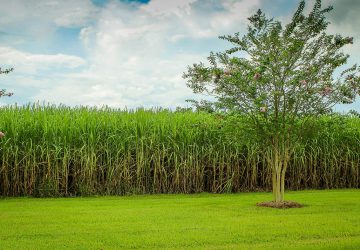Plant sources are fantastic for biodegradable food packaging. And there are so many to choose from! From bamboo, to wood, to recycled paper, plant starch, and even, as mentioned, sugar cane! And most of the time the products look just like ‘regular’ ones made of plastic. With one major advantage: they are completely eco-friendly.
This post is divided up in two parts, so as to offer a bit more detail for each source.
Bamboo

Bamboo is ideal for disposable food items. As a very fast growing plant, once it is cut down it makes for a fantastic renewable resource. Bamboo items are compostable, so they can be added to a home or commercial compost heap and will feed the soil, and help other plants grow. Make sure the bamboo comes from FSC certified sustainably-sourced forested areas. Bamboo is also biodegradable if exposed to bacteria, moisture, and heat.
Wood: Wood Cellophane
Wood cellophane, also compostable on a home compost heap, might sound like a made-up term, but it is very possible to create a clear product out of wood. Regenerated wood, cotton, or hemp cellulose are used to make wood cellophane. What makes wood cellophane ideal for food packaging is its ability to have a high barrier to air, grease, and bacteria. It can be also heat sealed, ensuring food safety. Ensure the wood cellophane used comes from FSC certified sustainably-sourced wood pulp. Wood cellophane products include bags, sheets, and rolls.
Wood: Birchwood

Birchwood is a great material for disposable cutlery. Birchwood trees are fast growing, and is a renewable resource. Make sure the Birchwood used comes from FSC certified sustainably forested areas. Birchwood is compostable, it can be added to a home or commercial compost heap and will feed the soil, and help the plants grow. It is also biodegradable if exposed bacteria, moisture, and heat.
Wood: Paper
Paper made from wood that is sourced from certified sustainable forests can be given ecological greaseproof properties, obtained during the pulping process – no coatings or chemical treatments are used. Greaseproof paper made in this way is compostable, it can be added to a home or commercial compost heap and will feed the soil. It is also biodegradable. Ensure it is produced by ISEGA, FDA and GOSPA and made from sustainable resources.
Recycled Paper

You can get pizza boxes, cup carriers, and paper bags that are made from recycled paper (also known as first generation waste paper). Items made from recycling paper are ideal for dry food goods. They can be added to a home or commercial compost heap and will feed the soil, and help the plants grow. They are also biodegradable if exposed to bacteria, moisture, and heat.
Bioplastics: Plant Starch
Bioplastic looks just like conventional plastic that is petroleum-based. However, appearances can be deceiving! Bioplastics is in fact made from plants sources like corn starch, hemp oil, and soy bean oil. The most popular source of bioplastic is industrial grade corn. Industrial corn is not edible, so this material won’t be take away any potential food. Plus, corn is sustainable and is renewable as it regrows within a year.

Benefits of bioplastic over traditional plastic include:
- Manufacturing of the bioplastics produces much fewer greenhouse gases.
- Manufacturing of the bioplastics uses less non-renewable energy.
- Drilling for oil is bad for the environment, growing plants is not!
- Bioplastics are non-toxic, meaning no toxins will leak into your food.
Bagasse: Sugar Cane
Bagasse is the fibre left over after the sugar cane has been pressed. It is a waste material, so by using Bagasse, food packaging manufacturers are using something that would be thrown away anyway. It is compostable. It can be used in a home or commercial compost heap. It will compost and feed the soil. Bagasse breaks down faster than any other biodegradable packaging.





